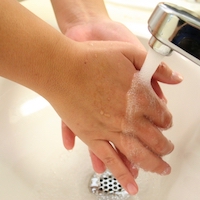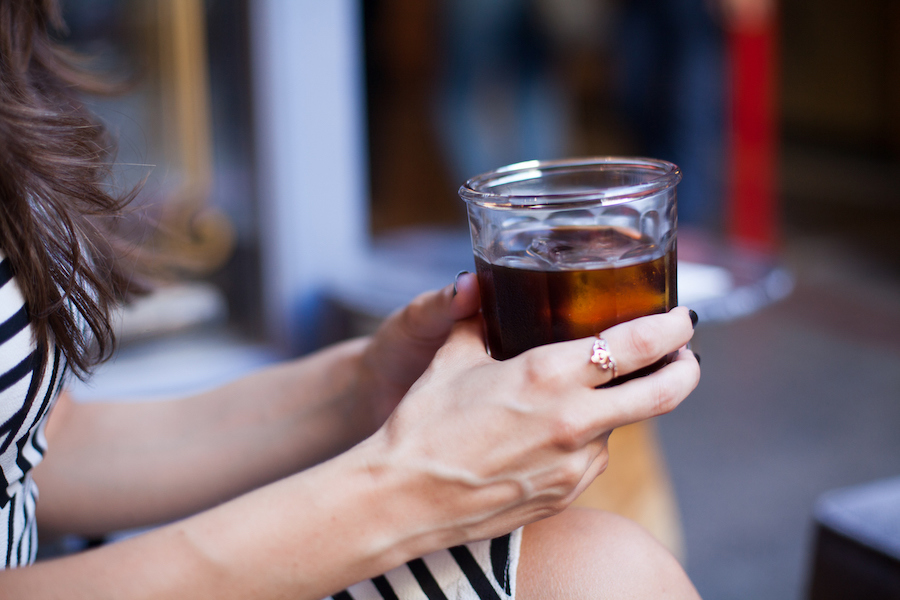To assist in providing this information, and to address concerns, University of Georgia scientists Laurel L. Dunn and Govind Dev Kumar, assistant professors in the department of food science and technology at the College of Agricultural and Environmental Sciences, have answered some common questions individuals may have.
Is COVID-19 likely to be transferred from food, including fresh produce, or water?As of now, there is no evidence to suggest that COVID-19 is transferred by food. Food manufacturers and produce growers, especially for commodities for which skin-to-produce contact occurs during harvest, should continue to follow the same practices they already use to reduce the risk of foodborne pathogens as they will also be effective against COVID-19. This includes sending sick workers home, frequent hand washing and glove use, and wearing clean clothing and appropriate personal protective equipment to work.
Which sanitizers can be used against COVID-19?
Several sanitizers are effective against the virus. If a product’s label says it is effective against coronaviruses or noroviruses (which are generally more difficult viruses to inactivate), it should be effective against COVID-19. See the U.S. Environmental Protection Agency’s list of approved disinfectants to be used against COVID-19 at epa.gov/newsreleases/epa-expands-covid-19-disinfectant-list. Always follow the EPA label for instructions concerning contact time, concentration and appropriate surfaces for use.
Bleach (sodium hypochlorite, Clorox), 70% isopropyl alcohol, povidone iodine and Lysol are all active against coronavirus on nonporous surfaces.
Bleach may be mixed at a rate of 1 tablespoon per gallon of water to sanitize food contact surfaces (contact time of at least one minute), and 3/4 cup to 1 gallon of water to disinfect floors and other surfaces (contact time of 10 minutes). Keep in mind this product will stain some materials.
Studies with povidone iodine (4% and 7.5%) in a skin cleanser and surgical scrub inactivated similar members of the coronavirus family (SARS-coV and MERS-coV) within 15 seconds. An optimal exposure time of two minutes was suggested.
Literature reviews of studies using similar but less infectious coronaviruses such as the SARS (severe acute respiratory syndrome) and MERS coV (Middle East respiratory syndrome coronavirus) have indicated that the use of 70% ethanol was effective against the viruses after a fairly short duration of exposure, up to four minutes.
Washing clothing and bedding with detergent in hot water (approximately 140 degrees Fahrenheit) is the most effective way to inactivate the virus on these surfaces as sanitizers are not effective on fabrics. Use gloves and extreme caution when handling clothing or bedding used by COVID-positive or suspected positive individuals.
Products that are not EPA labeled may not be effective against viruses and may be hazardous to humans and animals. Many individuals are resorting to homemade sanitizers, including products containing essential oils. Essential oils are skin, mucous membrane and eye irritants, and many are toxic to pets. Extreme caution should be used when applying these, either directly on surfaces or via aerosolization, around people or animals as serious reactions do occur.
How do I properly sanitize against COVID-19?
Sanitizing is a multistep process. First, surfaces with visible soil should be wiped clean, either with a clean, damp cloth, paper towel or wipe. Soap may be applied for surfaces with significant soil, then wiped or rinsed off. Once a surface dries, a sanitizer may be applied and should be allowed to air dry. Sanitizers require five to 10 minutes of contact time to inactivate microorganisms, so immediately wiping the surface will not allow sufficient time for viruses to be destroyed. Wipes, including Clorox Wipes, are useful for cleaning, but as the surface treated does not remain wet for more than few seconds, are not likely very useful as sanitizers. If spraying surfaces with sanitizer, be considerate and warn other individuals in the shared space as to why surfaces may be wet.
Can I use hand sanitizer instead of washing my hands?
Hand sanitizer is not effective on its own against bacteria and viruses on the skin. When applied to unwashed hands, the sanitizer is absorbed by dirt and dead skin cells and is unable to contact microorganisms on the skin surface. Washing hands for 20 seconds under soap and water is the most effective way to remove bacteria and viruses from hands. If desired, hand sanitizer may be applied after hands are dried to further reduce pathogens on hands. Hand sanitizer may also be used frequently between regular handwashing activities, or when there is no access to adequate handwashing facilities.
Am I likely to get COVID-19 from packages that are shipped to my home?
A recent study by the National Institutes of Health found that the virus does not appear to remain longer than 24 hours on cardboard, but can survive up to three days on stainless steel or plastic. However, large quantities of the virus were used in these studies, and the quantity of the pathogen present on surfaces did diminish over time. For this reason, it appears that the likelihood of virus transmission from packages is low. However, as transmission of the virus from contaminated objects has been documented, individuals may consider sanitizing all items that are delivered or brought into the home and wash hands after handling boxes or shipments they receive.
What is the best way to protect myself from COVID-19?
Avoiding people and areas accessible to the general public is the best way to reduce the likelihood of infection. Transmission occurs predominantly via aerosolization, such as when a sick individual coughs and spreads droplets into the air or onto surfaces that will be touched by other individuals. At this point in time, the Centers for Disease Control and Prevention recommends that immunocompromised or elderly individuals — and probably also people who care for these individuals — should reconsider activities that put them in close contact with groups of people, including air travel, dining out, sporting events and most social gatherings. All people should take precautions to limit close contact with each other, including handshakes and hugs, and should consider reducing the amount of time they spend outside the home. All activities that include large groups of people gathering should be reconsidered as this disease appears to be transmissible before an individual begins to show signs of illness. Frequent hand washing is critical before and after spending time in public, and frequently throughout the day. Hand sanitizer should never replace handwashing, but may be used to increase the effectiveness of handwashing.
This situation will continue to change rapidly, so continue to follow CDC, FDA and Georgia Department of Public Health updates.
As cases are continuing to increase, individuals with medical concerns or in high-risk demographics should consider having sufficient supplies on hand to last several weeks, should consider identifying an individual who can assist with shopping/errand running in the coming weeks and should begin reducing the amount of time spent outside the home.
Individuals not in high-risk demographics should be aware that they can transmit the disease even when they are still feeling healthy, and should take special precautions to protect the health of susceptible individuals, including limiting face-to-face contact, increasing social distancing and increasing handwashing.
Sick individuals and individuals who suspect they have been exposed should stay home and avoid contact with other people for 14 days. This virus has a long incubation period and again, illness may be spread before an individual begins to experience symptoms.







